
|
|

July 21, 2006
KMPC 1540, Los Angeles
By SCOTT FYBUSH
It's become an annual routine for the last few years - spending a few days before (or just after) the NAB convention visiting the many fascinating sites in the Los Angeles market. This week, we begin a multi-part recap of our 2006 LA visit, which ended up being packed into a single day after your editor was asked to give a Saturday-morning presentation at NAB, forcing a quicker return trip to Las Vegas than initially planned.
Our third stop on this busy Friday, following the KFWB studio and transmitter visits chronicled in last week's Site of the Week, was just a mile or so away from the KFWB/KLAC transmitters, up in the hills to the north.
The station in question is known today as KMPC - but that callsign's history really belongs to another Los Angeles AM, the 710 signal now known as KSPN. We'll tell the 710 story in another installment of Site of the Week someday, but for now, our dial is set at the 1540 position as we click on the "history" button...
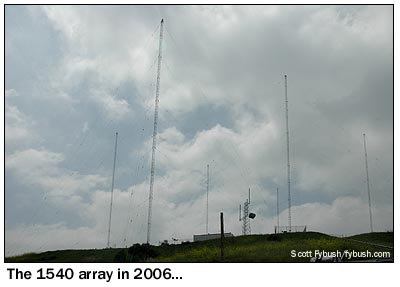 |
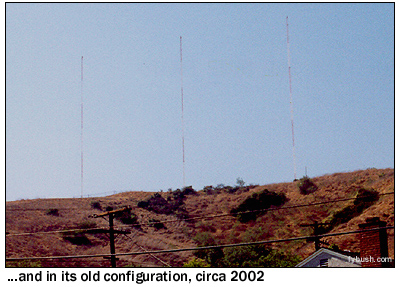 |
The 1540 signal in LA signed on in 1953 as KPOL, with 10 kilowatts, daytime only, into two towers on this site near the Ascot Reservoir. The third tower came along in 1957, when KPOL added a 10 kW night signal. Day power went to 50 kW in the early sixties, and by then KPOL-FM had been added up here, too, on 93.9.
After several decades with beautiful music, KPOL AM-FM became country KZLA AM-FM in the late seventies, and the FM went its separate way in 1984, eventually moving up to the KCBS site on Mount Wilson, where it operates today under Emmis ownership.
AM 1540 went Spanish, first as KSKQ, then KXED and KXMG. In 1997, it became the LA outlet for One-on-One Sports, as KCTD - and a few years later, as One-on-One became Sporting News Radio, 1540 adopted the historic KMPC callsign as its own. And just last year, KMPC completed a tower rebuild that replaced the three 1950s towers with six new towers, allowing an increase in night power to 37 kW (with an application pending to go to 46 kW at night.)
Yes, that means there were nine towers here at one time while construction was underway; no, alas, we weren't around to get pictures.
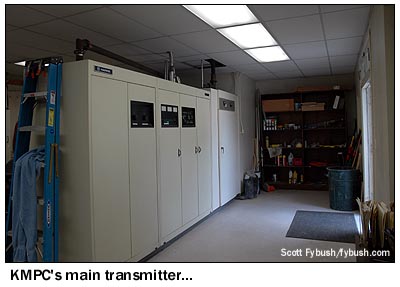 |
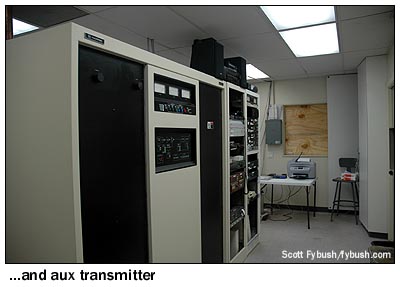 |
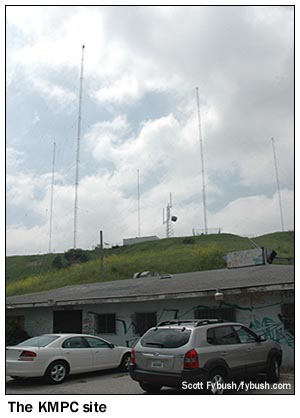
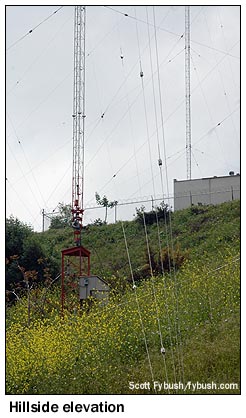 For
many years, the building just down the hill from the towers,
at the end of a twisty road leading up from Carter Drive, served
as not only KPOL's transmitter but also as its studio facility,
to the extent an automated beautiful-music station has a studio.
For
many years, the building just down the hill from the towers,
at the end of a twisty road leading up from Carter Drive, served
as not only KPOL's transmitter but also as its studio facility,
to the extent an automated beautiful-music station has a studio.
Later, when the studios had moved away, the building was turned into an apartment for engineers, and there are several veteran LA engineers who have called these rooms home over the years.
Most recently, it housed the tower crews while they were working on the site last year; because it's a wooden building in an area ravaged by wildfires, the plan is to tear it down eventually and to move the transmitters up the hill, where the towers are.
For now, though, the building sits mostly empty (with a few old city plaques honoring KPOL for long-forgotten good deeds gathering dust on the walls), and chief engineer Mike Tosch is happy to show off the slightly newer annex to the building (out of frame to the right in the exterior photo above) that's home to the current main transmitter, a Harris DX50, and to the aux, a DX10. Look closely to the right of the DX50 and you can see one cabinet that's still left from the original 50 kW General Electric transmitter that went in back in the sixties.
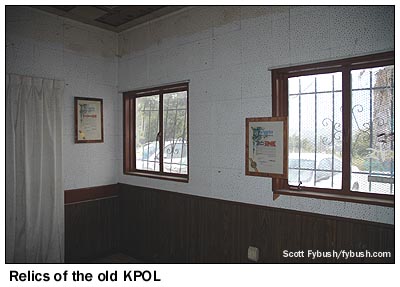 |
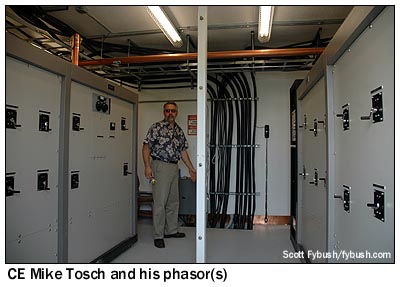 |
From the transmitter, we head up to the top of the hill to see the towers - well, five of them, anyway. The sixth tower had to be placed a little ways down the side of the hill, and that meant its base had to be elevated to match the height of the other five. And that meant that it, alone of the new towers, exceeded 200 feet in height and had to be painted and lit, never mind that it doesn't poke up any higher above the terrain than the five 199-footers on the hilltop.
There are three small buildings on the hilltop - one for the two-way users who populate a little communications tower up here, one that housed the old three-tower phasor, and a new one that houses the day and night phasors for the new towers.
From here, it's back down the hill for a quick lunch - and then up another, much taller, hill for a date with some even more unusual LA tower history. We'll get there next week!
|
STILL HERE - BUT WE NEED YOUR SUPPORT: If you're a fan of the national radio message-board sites, you're probably feeling a little disoriented lately by all the changes they're going through. (We are, too, though we've pretty well settled on the new radioinsight.com as the friendly spot to talk about all things radio and TV.) Here at fybush.com, we're now in our twelfth year of regular, uninterrupted service to our readers, and we're not going anywhere. Same address, same weekly columns, same old design. (OK, perhaps a few things could use some freshening this year.) And if we've learned anything after all those years in the radio website business, it's this: good things don't come for free. Or at least when they do, they don't last forever. But thanks to our loyal subscribers and our growing fleet of advertisers, we've built a solid community here. We were here in 1994, we're here in 2006, and assuming there's still a radio dial to cover, we have every intention - with your support - of still being here in 2018. (I wish I could say the same about my hairline.) If you still haven't subscribed yet for this year, do it right now at our Support page - and enjoy another exciting year of Tower Site of the Week and NERW, guilt- (and password-) free. And if you have become one of our many subscribers, thank you! |
- Previous Site of the Week: KFWB/KLAC, Los Angeles, CA
- Next Week: KROQ 106.7, Verdugo Hills, Glendale, CA
- Site of the Week INDEX
- How can you help support Site of the Week? Click here!
- Submit your suggestions for a future Site of the Week!
